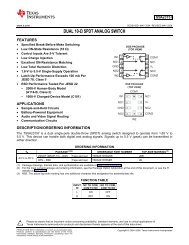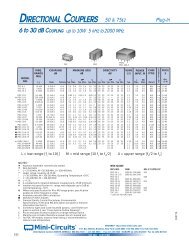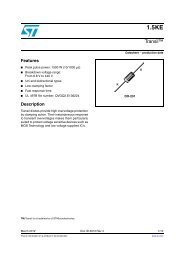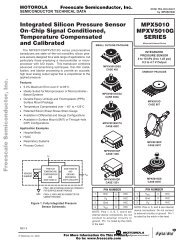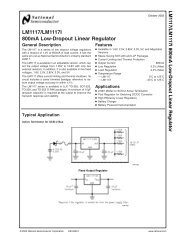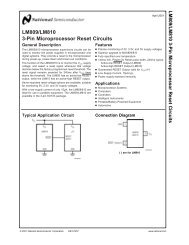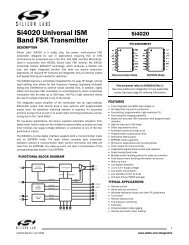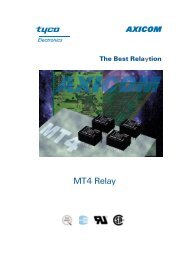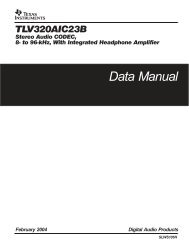LM3445 Triac Dimmable Offline LED Driver
LM3445 Triac Dimmable Offline LED Driver
LM3445 Triac Dimmable Offline LED Driver
You also want an ePaper? Increase the reach of your titles
YUMPU automatically turns print PDFs into web optimized ePapers that Google loves.
<strong>LM3445</strong><br />
The off-time of the <strong>LM3445</strong> can be programmed for switching<br />
frequencies ranging from 30 kHz to over 1 MHz. A trade-off<br />
between efficiency and solution size must be considered<br />
when designing the <strong>LM3445</strong> application.<br />
The maximum switching frequency attainable is limited only<br />
by the minimum on-time requirement (200 ns).<br />
Worst case scenario for minimum on time is when V BUCK is at<br />
its maximum voltage (AC high line) and the <strong>LED</strong> string voltage<br />
(V <strong>LED</strong> ) is at its minimum value.<br />
The maximum voltage seen by the Buck Converter is:<br />
Given a fixed inductor value, L, this equation states that the<br />
change in the inductor current over time is proportional to the<br />
voltage applied across the inductor.<br />
During the on-time, the voltage applied across the inductor is,<br />
V L(ON-TIME) = V BUCK - (V <strong>LED</strong> + V DS(Q2) + I L2 x R3)<br />
Since the voltage across the MOSFET switch (Q2) is relatively<br />
small, as is the voltage across sense resistor R3, we<br />
can simplify this to approximately,<br />
V L(ON-TIME) = V BUCK - V <strong>LED</strong><br />
During the off-time, the voltage seen by the inductor is approximately:<br />
V L(OFF-TIME) = V <strong>LED</strong><br />
The value of V L(OFF-TIME) will be relatively constant, because<br />
the <strong>LED</strong> stack voltage will remain constant. If we rewrite the<br />
equation for an inductor inserting what we know about the<br />
circuit during the off-time, we get:<br />
INDUCTOR SELECTION<br />
The controlled off-time architecture of the <strong>LM3445</strong> regulates<br />
the average current through the inductor (L2), and therefore<br />
the <strong>LED</strong> string current. The input voltage to the buck converter<br />
(V BUCK ) changes with line variations and over the course of<br />
each half-cycle of the input line voltage. The voltage across<br />
the <strong>LED</strong> string is relatively constant, and therefore the current<br />
through R4 is constant. This current sets the off-time of the<br />
converter and therefore the output volt-second product<br />
(V <strong>LED</strong> x off-time) remains constant. A constant volt-second<br />
product makes it possible to keep the ripple through the inductor<br />
constant as the voltage at V BUCK varies.<br />
Re-arranging this gives:<br />
From this we can see that the ripple current (Δi) is proportional<br />
to off-time (t OFF ) multiplied by a voltage which is dominated<br />
by V <strong>LED</strong> divided by a constant (L2).<br />
These equations can be rearranged to calculate the desired<br />
value for inductor L2.<br />
Where:<br />
Finally:<br />
30060340<br />
FIGURE 17. <strong>LM3445</strong> External Components of the Buck<br />
Converter<br />
The equation for an ideal inductor is:<br />
Refer to “Design Example” section of the datasheet to better<br />
understand the design process.<br />
www.national.com 18



